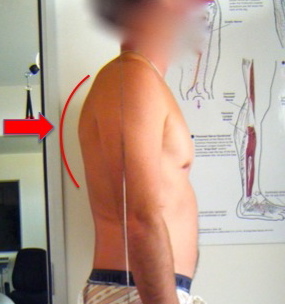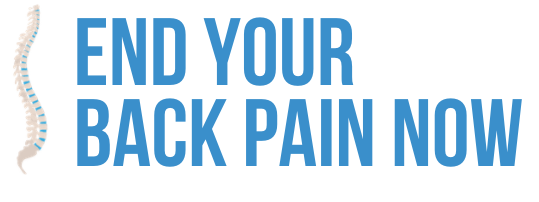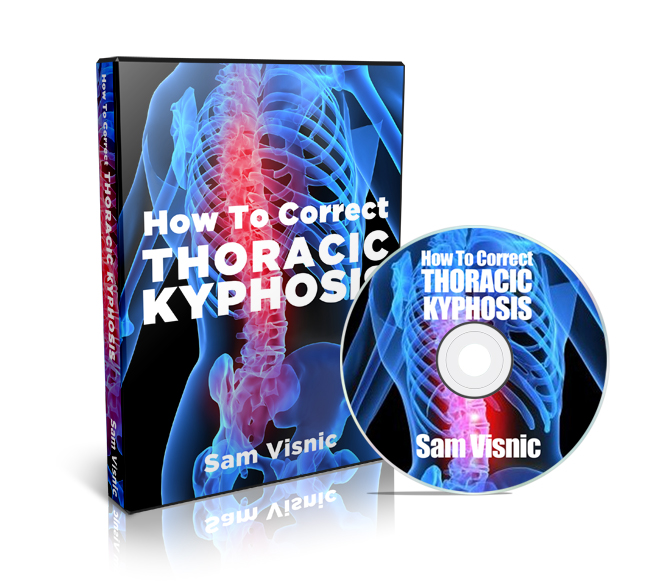What Is Thoracic Kyphosis?
Kyphosis refers to a natural curvature of the portion of the spine called the thoracic spine. The opposite curvature, called the lordosis typically occurs in the cervical and lumbar spine.
Since kyphosis is natural in the spine, we have to identify what excessive kyphosis is, which is generally the problem. Generally speaking, a normal for a thoracic kyphotic curve measures between 30 to 35°. In excessive kyphosis would be greater than 35°.

Many times, however, it’s important to realize that the thoracic curvature is only greater than 35° when you’re slouching, and in many cases corrects into the normal range as you stand upright. So a quick test involves this: stand sideways in the mirror, and look at your curvature in your thoracic spine. Now, imagine that you have a hook attached underneath your sternum and it is pulling up to the sky. As you perform this motion, notice what happens to your thoracic curve, when you look in the mirror.
A second test can be performed, which may determine whether there is a lack of mobility in the thoracic spine. In this test, you will perform the exact same movement, with the exception that you will lift your arms up and behind your head and as far as you can comfortably go, and notice what happens to your curve. Typically, the thoracic spine should decrease in curvature by approximately 14°, or be straight. Oftentimes this is difficult to eyeball, so in my clinic I use special calipers to measure this. However, since you don’t have these, eyeballing it will have to do.
If you are not able to reduce your curve enough, there may be some rigidity in your thoracic spine and you may need mobilization work.
What Causes Kyphosis?
Excessive thoracic kyphosis can be caused by some random things such as nutritional imbalance as a child, such as vitamin d deficiency, or problems with growth plates. The majority of excess kyphotic postural problems occur frankly from slouching! Bad postural alignment today is rampant, particularly since we spend so much more time on the computer.
Another cause for kyphosis involves a strong mental-emotional component. Emotional states such as depression, worry, anxiety, lethargy, and hopelessness lead to a slouching of posture. Many times, however, if the kyphosis can be completely corrected by standing upright, and these emotions are present, they may need to be addressed as the root cause.
Treatment for Kyphosis:
Excessive thoracic kyphosis can be treated in a number of ways naturally. Its important to realize, however, that correction of kyphotic posture takes time. It involves exercises, stretches, mobilizations, as well as continual postural correction. You’re looking at anywhere from 3 months to 1 year to make significant progress on reducing excessive postural kyphosis.
Kyphosis Exercises:
Here are a couple of great exercises for strengthening the muscles that support extension of the spine.
The Prone Extension: This is a drill that I include in the Back to Stability online program. It is a lying down exercise that focuses on strengthening the muscles of the upper back, which over time, can reduce the excess kyphotic curve in the thoracic spine.
Kyphosis Stretches:
While it is essential to strengthen the muscles that are causing the slouching of the thoracic spine to occur, it is also important to stretch the muscles that are holding the postural dysfunction in place. Two muscles that can significantly contribute to excess thoracic flexion include the abdominals, as well as the diaphragm.
Abdominal stretching: Stretching your abs can help tremendously in reducing thoracic kyphosis, because at the same time you stretch them, you are mobilizing your spine. One of the best ways to stretch your abs is by laying over a swiss ball. Its important to make sure you relax as you do this stretch, and breath naturally, as this will serve to improve the release you get.
Foam rolling the thoracic spine: This technique involves laying over a foam roll, like what you find in the gym, for the purpose of mobilizing your spine. Basically this means stretching it backwards over the roll. This technique can be quite tender on your spine at first, particularly at those spinal segments that are not moving very well, but can improve quickly over about 2 weeks with consistent work on the roller.
Click here to access my recorded webinar, How to Correct Thoracic Kyphosis
As you have likely found, general searches on the net have only returned medical-type websites that have no useful information on them, or lame sketch drawings of exercises. Due to the high amount of email requests I have received to reveal my protocols for correcting kyphosis, I finally gave in.
For the past 16 years I have been collecting corrective stretches, mobilizations and exercises from the best physical therapy and movement textbooks, and I’ve put together a unique 3 phase program for correcting the thoracic spine. I’ve put my approach on a program called “How To Correct Thoracic Kyphosis”. This online program contains the protocols I use with my personal clients to help them get out of middle and upper back pain, as well as a prerequisite to addressing the neck.

